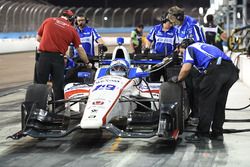Honda “still needs to figure out" its new IndyCar aerokit
HPD CEO Art St. Cyr has said, while he was pleased a Honda-powered car topped Phoenix’s Friday evening session, he does not believe the full potential of the new aerokit has been tapped.

Photo by: IndyCar Series










In the afternoon session, the fastest Honda-powered car – that of Graham Rahal’s Rahal Letterman Lanigan Racing entry – was 2.5mph off the top Chevrolet runner, Helio Castroneves.
But St. Cyr said just as he wasn’t elated by Marco Andretti’s Andretti Autosport-Honda heading the field in the evening, he hadn’t been worried by the HPD cars’ apparent struggle earlier in the day.
He told Motorsport.com: “IndyCar changed the aero specification for this test and so we didn’t exactly come here prepared. We’ve been a little bit behind the eight-ball, trying to get all the pieces in.
“Everything has been a little bit up-in-the-air. So this afternoon I wouldn’t say we were panicked or anything. We still need to figure things out.”
Despite IndyCar’s now infamous imposition of Rule 9.3, which allowed Honda to modify its 2015 aero kit in more areas than Chevrolet, in order to catch up with the superior Chevy kit, St. Cyr acknowledged that there are no guarantees the deficit has been overcome.
He said: “My belief is that the regulations were devised to keep us close, so there wasn’t a dominant force. Rule 9.3 let us close up the gap, but we weren’t given free rein to do whatever we wanted to do. We had a threshold and then stopped.
“So we knew it wasn’t going to be easy. The competition is strong, they weren’t standing still, so we need to learn how to drive this car just like we learned to drive the other car. But we move forward every day, so hopefully Saturday will give a pretty good idea of where we stand.”
Keeping it in-house
St. Cyr explained that although lessons learned from 2015 were applied to the new 2016 aerokit, the results came from a different source.
He said: “We used Wirth Research expertise for last year’s kit, but we kept this one within Honda. It’s been a collaboration between HPD [California-based Honda Performance Development] and Honda Japan’s R&D office. A lot of the Formula 1 aerodynamicists in Japan were made available to help us do this one.”
However, he also added that reduced drag had been less of a priority than making the cars more consistent in to drive.
“Our modifications to the aero kit were not so much about improving ultimate performance but about making the car’s handling more predictable,” said St. Cyr. “Improving predictability makes a driver more confident to go harder into the corners, approach the limits better, and therefore improve performance.
“It wasn’t just one thing that needed fixing but a bunch of little things that had been making the car’s behavior inconsistent.”
St. Cyr said the HPD engine had also made notable progress over the off-season, even though that was less crucial than improved airflow.
“Based on our analysis, our engines seemed pretty strong last year,” he remarked, “but still we’ve made some pretty significant upgrades to the engine over the winter.
"The homologation rules for the engine were opened a lot more this time around, so we took advantage of that and actually made a pretty big leap in the off-season.
Wary of abrupt aero changes
One of the themes of this test has been the huge G-forces being generated by the new aerokits around Phoenix’s 1.022-mile track.
IndyCar’s new vp of competition, Bill Pappas, told Motorsport.com he wouldn’t be averse to significantly reducing the cars’ downforce before the race on April 2, but St. Cyr suggested that a radical change was unlikely and possibly unworkable.
“I’m not going to say what IndyCar should or shouldn’t do,” he said, “because ultimately it’s about driver safety as No. 1 priority, and secondly we want to have a good race, not a parade.
"IndyCar sees our stuff and sees the other side’s stuff and they’ll make a determination on how to run the cars. That’s the purpose of this test.
“But we designed the kit to the rules, so removing homologated parts… We’ve never run the kit without those parts, so if we’re forced to start taking them off, that’s going to be hard to manage.
“We have our kit, they [Chevrolet] have their kit, and both were designed around IndyCar’s rules. Everything is going to be based around that frame of reference. That ship’s already sailed.”
Be part of Motorsport community
Join the conversationShare Or Save This Story
Subscribe and access Motorsport.com with your ad-blocker.
From Formula 1 to MotoGP we report straight from the paddock because we love our sport, just like you. In order to keep delivering our expert journalism, our website uses advertising. Still, we want to give you the opportunity to enjoy an ad-free and tracker-free website and to continue using your adblocker.















Top Comments